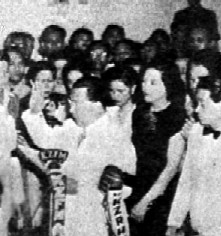| ELPIDIO QUIRINO | ||
|
President Quirino was born in Vigan, Ilocos Sur on November 16, 1890 to Mariano Quirino, a commissioned officer in the Spanish army, and Gregoria Rivera. He received his first schooling from his parents. After they moved to his mother's home province, he enrolled in a private school to study English grammar. He then transferred to the Aringay Elementary School and later studied in the provincial school of San Fernando, La Union. In 1904 the family returned to Vigan. Pidiong then continued his studies in the town's high school, after which he applied for a teaching job at the Capariaan barrio school. 
Fired with a high ambition, Elpidio continued his studies in Manila as a working student. His oratorical ability was developed when he enrolled as a sophomore at the Manila High School. He worked as a property clerk in the Manila police department and sketched and illustrated for publications to meet his expenses. After obtaining a law degree from the University of the Philippines in 1915, he served as law clerk in the Philippine Commission, the upper chamber of the legislative set-up at that time. With the approval of the Jones Act in 1916, the Philippine Commission gave way to the Philippine Senate; he then transferred to the latter. The new Senate President Manuel Quezon made him his secretary. In 1919 he was elected as representative in his congressional district in Ilocos Sur, thus opening his political career. Not long thereafter, he married Alicia Syquia, a scion of a wealthy family in Vigan, on January 16, 1921. His wife and three of their children fell victims of Japanese massacre in February 1945 at the height of the Liberation Campaign in Manila. 
In 1925 Quirino was elected senator at the comparatively early age of 35. He was reelected in 1931 for another six-year term. In 1934 he was a member of the Philippine independence mission to Washington, DC, headed by Manuel Quezon. The mission was responsible for securing the passage of the Tydings-McDuffie Act, setting the date for Philippine independence as July 4, 1946. He was also elected to the convention that drafted a constitution for the new Philippine Commonwealth. Subsequently, he served as secretary of finance and secretary of the interior in the Commonwealth government. After World War II, he served as Secretary of Foreign Affairs and Vice President under the first president of the independent Philippines, Manuel Roxas. When Roxas died on April 15, 1948, Quirino succeeded to the presidency. The following year, he was elected president for a four-year term on the Liberal Party ticket, defeating the Nacionalista candidate, Jose P. Laurel. 
Quirino's six years as president were marked by notable postwar reconstruction, general economic gains, and increased economic aid from the United States. He focused attention on two major goals: restoration of the faith of the people in the government and total economic mobilization. To achieve the first objective, he intensified house-cleaning in the government to weed out the corrupt. For his second goal, he supported the establishment of several industrial plants and projects at strategic points all over the country, thereby mobilizing its economic resources and ushering in an era of industrialization. Among these industrial achievements were the Burgos irrigation project in Zambales, the hydroelectric project in Lanao, a network of roads all over Mindanao, the cement factory in Bacnotan, La Union, and many new and necessary industries which provided employment to thousands. Thus, Quirino is acclaimed as the “Father of Philippine Industrialization.” Quirino sought reelection in 1953 but lost to Ramon Magsaysay. In May 1955 Quirino visited Japan primarily to convalesce. He was accorded a warm welcome in reciprocation of the magnanimous act he did, while President, of extending amnesty to the Japanese prisoners of war who were then serving their sentence at Muntinlupa. After his term, he retired to his new country home in Novaliches, where he died of a heart attack on February 28, 1956. |
||
| Back | Next |